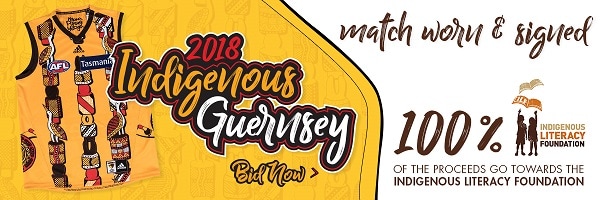The AFL’s Sir Doug Nicholls Round is one of the most significant weekends on the football calendar.
It is a weekend of recognition and celebration of Indigenous culture.
Every club produces their own commemoration with the design of a specialised Indigenous-themed guernsey, which all possess a meaning behind them and a story to tell.
This year’s Hawthorn guernsey designer, Jennifer “Lulu” Coombes, has many good stories to tell.
“I just had a message from Cyril one day for me to call him because he needed me to do something,” Coombes said.
“So, I called him and he sort of gave me a rundown, saying that they were doing an Indigenous jumper and he was wondering if I was interested in doing a design.
“I said for him to give me time to think about it and after about two or three weeks, I told him I was interested.”
She has known Cyril Rioli since he was born.
Jennifer Coombes, or Aunty Lulu to Cyril, is a cousin of Rioli’s father, Cyril Jnr, and her and Cyril are in constant contact.
A footballer herself, she used to play with Cyril’s younger sister, Kahlisha, who she describes as a “really hard, tough player”.
Like Rioli, Coombes comes from Pirlangimpi on the west coast of Melville Island, one of the two inhabited islands that make up the Tiwi Islands.
Her grandfather was a tribal leader of this area and senior song man, while her grandmother was a Traditional Owner and Elder.
She has been surrounded by a family with a strong background of artists.
“Since we were really little, I was learning from my grandfather and my mother.
“My mum used to work in an arts centre and my grandfather used to come into school, along with others, to teach us about culture, and how to do things like paintings and carvings.”
Coombes believes the jumper is a representation of life on the Tiwi Islands.
“Footy is a really important part of our culture, it is sort of like a second religion for the Tiwi people.
“Pretty much from before you can crawl or walk, you know how to play footy!”
As for the jumper itself, its design features two prominent aspects of the Tiwi culture, Pukumani Poles and the Kulama ceremony.
Pukumani Poles, which are found on the front of the guernsey, are commonly used in ceremonies and are also placed around the graves of the deceased in order to protect the passed from evil spirits.
The art on these Poles is unique, often telling a story about the departed individual.
On the back of the guernsey, the circular figures are a depiction of a Kulama Yam Ceremony.
Such ceremonies occur at the beginning of the dry season, around the months of April and May.
They run over three days and nights, with the rituals conducted by Tiwi men and women who participate in the ceremony.
Songs are composed to tell of events, both positive and negative, that have occurred on the Islands in the past year.
“I chose the designs of the Kulama because, for me, it’s a means for celebration of life past, present and future.
“I wanted to use it as a meaning to celebrate the life of all the Indigenous players past, present and future, that have walked the path in their footy careers with Hawthorn and in footy in general.”
Coombes’ final touch is inside the guernsey.
“Junior Boy (Rioli) asked to have Tiwi wording on the jumper, so I called my aunty Therese Marie and, after a week and a half of consulting with Old Lady Callista Kantilla, we agreed on the wording.”
The wording they settled on is “Ngawa Puranji Yiloga”, which translates to “We love our footy”.
“I feel honoured and privileged that my nephew, Cyril Rioli, has asked me to design this year’s Indigenous jumper,” Coombes said.
“Not just for our family, but the whole of Tiwi Islands and the Tiwi people, to be able to showcase our culture on the footy arena is just an awesome feeling.”
To watch the full interview with Cyril, tune into Channel 7's broadcast of our Round 4 clash with Melbourne at half time.
All of Hawthorn's Indigenous Programs are made possible by the wonderful support of the Epic Good Foundation.




